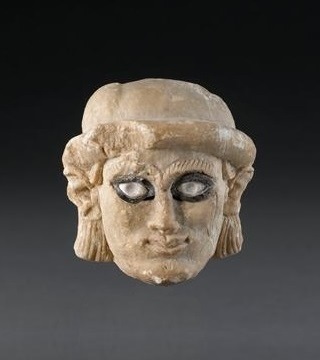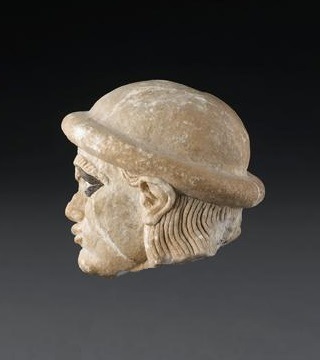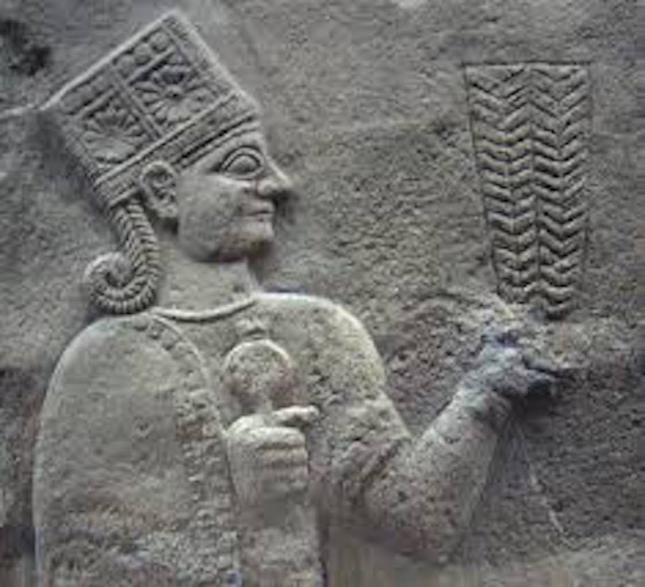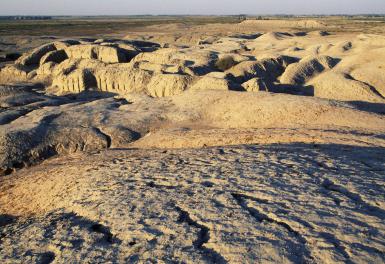
A little too much eye makeup! (Source)
A long while ago, I wanted to write about Ku-Baba, the only woman on the Sumerian King List. I went first to my go-to source on anything Sumerian, Sumerian Shakespeare, and found that Jerald Starr, the brain behind the site, had not mentioned Ku-Baba at all. It was as if I was just imagining this rather intriguing figure.
Nonetheless, I wrote to Starr with the hope he would have some information about Ku-Baba, or at least a good source he could point me toward. His response, which was basically doubt that she existed at all, left me feeling like I was at a dead end at the time, so I abandoned the idea of writing about her.
Fast forward to today, and Starr has changed his mind. “I had to revise my opinion,” he wrote to me in a surprise email. He also included a link to a new post on his website, in which he explains in detail how he arrived at the conclusion that Ku-Baba might have existed after all.
“For a long time I doubted that Ku-Baba even existed,” he writes in the post. “I believed the reference was a sly mean-spirited joke by the scribe who wrote the King List.”
What changed Starr’s mind was an alabaster statue at the Louvre from Girsu, with a little too much eye makeup to be just your run-of-the-mill Sumerian priestess, as he had initially believed. “When I first saw the statue, I believed it was a Sumerian priestess because she seems to be wearing a circular headband,” he writes, “. . .although for a priestess I thought she was a bit heavy-handed with the makeup.”
From the eyes, Starr traveled back up to the head, where it became clear to him that it was no headband this statue was wearing–that it was a hat he’d never seen on a Sumerian woman before. “The hat on the statue most closely resembles a shepherd hat, the crown of a Sumerian king,” he writes.

That’s no headband! (Source)
And from there, Starr writes as only he can about the minutest details to put Ku-Baba, the first woman ruler in history, back into the realm of possibility, giving me a chance to write about Ku-Baba like I had originally wanted.
The First Woman Ruler

Ku-Baba. (Source)
Ku-Baba, Kug-Bau in Sumerian, is the only female monarch on the Sumerian King List. She ruled between 2500 BC and 2330 BC. On the list itself, she is identified as:
… the woman tavern-keeper, who made firm the foundations of Kish, became king; she ruled for 100 years.
Every source I came across in my research, including Starr, questioned how a woman who was a tavern-keeper became king. They then went on to explain that tavern keeping was one of many occupations Mesopotamian women could hold. Now, aside from Starr, said sources all described tavern keeping as a well-respected occupation, even while some mentioned that taverns in Sumer were pretty much brothels. This complicates further the rationale of a woman tavern-keeper becoming king, but in her About.com article titled, “Kubaba, A Queen Among Kings,” Carly Silver writes, “Regardless of what kind of show they were running, women often ran taverns, holding perhaps one of the only independent female positions of power in ancient Sumer.”
Silver drives home the rather high status of the tavern-keeper profession by mentioning Siduri, the female tavern-keeper Gilgamesh meets in the Underworld in his quest for immortality in the epic of his namesake. In it, the tavern-keeper gives Gilgamesh, a powerful god-king, sage advice about the nature of human life, how short it is, and how one ought to enjoy it.
“So, in what was probably a very important epic even in antiquity,” she writes, “a female tavern-keeper was seen as a guide along perilous paths and a figure worthy of veneration.”
Conversely, Starr’s description of the status of a tavern-keeper, or barmaid, is one that is very different from Silver’s. He writes, “Throughout history, a barmaid was typically considered to be a woman of loose morals, freely available to the patrons of the tavern, and little better than a common prostitute.”
So, how can this be? Several sources commend tavern keeping as a respectable occupation, almost making it sound like it was a foot in the door for Ku-Baba to become queen in her own right, while one all but ascribes it to prostitutes.
It helps that Starr does mention a distinction between a mere barmaid who slings drinks and provides patrons with her company, and someone who owns the establishment where this business takes place, a distinction other sources do not mention. Starr also classifies an owner of a tavern as “middle class,” while iterating that the employee slinging the drinks is “a commoner, and a lowly commoner at that.”
Furthermore, in order to see more clearly how tavern keeping relates to Ku-Baba’s rise to royalty, it helps to look at the picture in a different way.
According to Starr, even though there is no question Ku-Baba was a commoner, she might not have been a tavern-keeper. Starr states in his post that it was her parents who were tavern-keepers, a nugget he says her enemies distorted and used against her to tarnish her reputation and legacy. “I believe Ku-Baba was unfairly characterized as a bawd (the usual description of a female barkeeper) for propaganda reasons,” Starr writes. “I believe it was a deliberate attempt to sully her reputation. It is the kind of thing her enemies would say about her.”
Bottom line, we must let go of the idea that Ku-Baba was a tavern-keeper to get to the bottom of how she became a queen in her own right, because everything is questionable when you have an enemy, which she did, according to Starr.
And who was that enemy, you ask? Sargon of Akkad, our favorite baby in a basket here at AllMesopotamia.
Again, I point you toward Starr’s article for a more comprehensive telling of this story and presentation of the case involving Ku-Baba’s previous profession, but Sargon of Akkad usurped the throne of Kish from Ur-Zababa, Ku-Baba’s grandson, 31 years after her death, serving as background for Starr’s conclusion.
But how did Ku-Baba take the throne?
In her article titled “Ku-Bau, the First Woman Ruler,” Darci Clark writes, “In general, other women in Mesopotamian society would only be able to exert any political influence through their relationships to the king.”
Starr echoes Clark’s statement: “Sumerian queens were always the wives of kings. They never governed on their own.”
Okay, but would a king marry a commoner?
“Although it is highly unlikely that a king would marry a commoner,” Starr explains, “it is certainly within the realm of possibility.”
It’s possible Ku-Baba married a king, but there is no mention of such a thing happening in ancient texts. Nevertheless, a king was involved. According to Clark, Ku-Baba became lugal of Kish after performing an act of kindness. It seems that a king–Puzur-Nirah, king of Akshak, namely–awarded Ku-Baba her kingship for a “pious deed.”
Researching this further, I came across an article on the website History Hustle, titled “Kubaba, the Bartender Who Became the First Woman Ruler in History,” which pointed me toward the Weidner Chronicle, an interesting ancient Babylonian religious text, where the deed and its reward are described:
In the reign of Puzur-Nirah, king of Akšak . . . Kubaba gave bread to the fisherman and gave water, she made him offer the fish to Esagila. Marduk the king, the prince of Apsu, favored her and said: “Let it be so!” He entrusted to Kubaba the tavernkeeper, sovereignty over the whole world. (Lines 43-45, Weidner Chronicle)

The city of Kish. (Source)
A Feminine Legacy
Very little is known about Ku-Baba’s reign. We do know that she made Kish strong, and that she reigned for 100 years. It is easy to conclude then that she was a successful monarch. Really, there’s no way she could have not been.
Starr writes, “Any female pretender to the throne who didn’t do an excellent job would quickly find herself in the middle of a coup d’état. She was capable enough, and respected enough, to stay in power and establish a dynasty.”
That dynasty, the 4th Dynasty of Kish, lasted for two generations, ending with the above-mentioned Ur-Zababa, son of Puzur-Suen, son of Ku-Baba. Not bad for a woman living in a man’s world, and a man’s world it was.
Carly Silver writes that Ku-Baba’s was remembered by later generations as an improper usurper. They would also refer to Ku-Baba when describing things that are not as they should be–women taking on men’s roles has never been popular. “By taking on the duties of a man – a king – Kubaba was seen to have crossed a boundary and transcended gender divisions in an improper fashion,” Silver writes.
Ku-Baba was also referenced when a lung didn’t look so good, or a child was born with both male and female genitalia. “Combining male and female genitalia in an individual would echo her reign as lugal, or king, which the ancients saw as violating the natural order of things,” Silver writes.
Nonetheless, Ku-Baba lived in people’s memories until Babylonian times, becoming a goddess. “But she was still a barmaid,” Starr explains. “She is portrayed as a kindly woman in all of the stories about her . . . Ku-Baba never lost the ‘common touch’. Queen Ku-Baba was always ‘the people’s queen’.”
Whether her legacy when she was an actual memory was a positive or negative one, today, in 2017, Ku-Baba’s legacy is that of (written) history’s first woman ruler, one who could only be slandered by a past that might have been falsified by her enemy, and one whose ascendancy to the throne was built upon kindness.
How feminine. How fitting.
P.S. Make sure you read Starr’s Ku-Baba post, as there are things and photos I did not include here that are sure to pique your interest further in this interesting lady. And while you’re at it, if you haven’t already, read our Q&A interview with Sumerian Shakespeare himself!
Sources and Further Reading:
Queen Ku-Baba – Sumerian Shakespeare http://sumerianshakespeare.com/748301/769001.html
Sumerian King List – http://www.livius.org/sources/content/anet/266-the-sumerian-king-list/
Ku-Bau: The First Woman Ruler – Darci Clark http://semiramis-speaks.com/ku-bau-the-first-woman-ruler/
Kubaba, A Queen Among Kings – Carly Silver http://ancienthistory.about.com/od/sumer/fl/Kubaba-A-Queen-Among-Men.htm
Kubaba, the Bartender Who Became the First woman Ruler in History http://historyhustle.com/kubaba-bartender-became-worlds-first-woman-ruler/
Weidner Chronicle http://www.livius.org/sources/content/mesopotamian-chronicles-content/abc-19-weidner-chronicle/?







